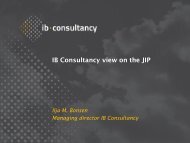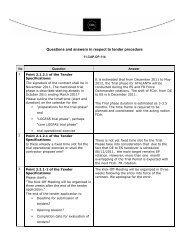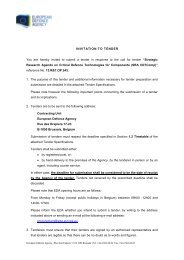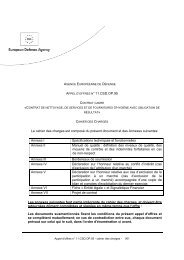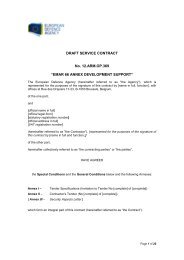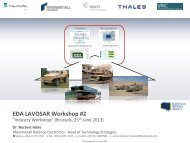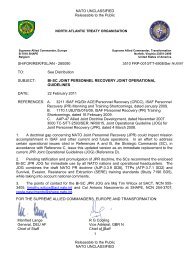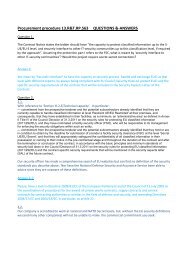capability development plan - European Defence Agency - Europa
capability development plan - European Defence Agency - Europa
capability development plan - European Defence Agency - Europa
Create successful ePaper yourself
Turn your PDF publications into a flip-book with our unique Google optimized e-Paper software.
34<br />
STRATEGIC DRIVERS<br />
states and citizens worldwide, it will also put societies under stress. There will be those who are able<br />
to utilise the possibilities that emerge, but there will also be those who do not.<br />
2. Geographical cleavages between successful communities and states and less successful<br />
communities characterised by high unemployment rates, low income levels, and high levels of<br />
criminality will continue to develop.<br />
3. Many citizens within and outside EU are feeling socially and economically insecure. Increased<br />
corruption, shift in values, and the increased importance of formal and informal non-governmental<br />
institutions and social networks are likely to exaggerate this <strong>development</strong>. Modern information and<br />
communication systems will strengthen these trends.<br />
4. Due to migration, developed countries will continue to get more heterogeneous.<br />
5. Changes in values and personal interests of young people may make them less fit as soldiers both<br />
mentally and physically.<br />
POTENTIAL SOURCES OF CONFLICT, THREAT AND HUMANITARIAN TRAGEDY<br />
6. Ongoing migration streams will increase cleavages within Europe and will form a breeding ground<br />
for ethnic and religious radicalisation.<br />
7. When disadvantaged communities develop into isolated enclaves within states, or on the level of<br />
states within the global community, failed or extremely soft extremism is likely to flourish, which may<br />
lead to violent conflicts where opponents engage in urban guerrilla warfare, terrorism and organised<br />
crime.<br />
8. A state losing legitimacy among its citizens is problematic in several ways. Without strong legitimacy,<br />
a state may experience difficulties in sustaining its institutions including the armed forces. And at the<br />
extreme end other institutions and organizations may even challenge the state’s monopoly on violence<br />
by developing their own armed forces.<br />
POSSIBLE CONSEQUENCES FOR DEFENCE<br />
9. Concepts – Shifting values, ethnically mixed society, pressures in public spending, 24/7 media<br />
coverage over horrors of war and on the other hand missing tangible military threat may lessen public<br />
willingness to sacrifice scarce resources to defence (spending and people). Armed forces will need to<br />
justify the demand for capabilities to be developed and maintained.<br />
10. Operational concepts may need to be adapted to allow more flexible co-operation with other actors<br />
in theatre. These actors will include Private Military Companies and other institutions responsible for<br />
“traditional” military duties (outsourcing).<br />
11. Training – Troops will increasingly need to be able to cope with multicultural societies. That may<br />
increase need to integrate immigrants to armed forces structures in order to gain public support. On the<br />
other hand, the immigrants may have diverging cultural and educational background that will have to<br />
be taken into account in training.<br />
12. Armed forces may become less attractive career choice. As a result people recruited to armed<br />
forces may have poorer educational background. At the same time complexity of operating<br />
environment and military tasks will continue increasing. EU forces will need to able to take appropriate<br />
action timely and in concert with other actors.<br />
13. Equipment – Increasingly heterogeneous recruitment base will have to be taken into account when<br />
equipment is developed.<br />
14. EU forces, down to the individual level, will have to be able to negotiate with complex situations<br />
often among civilian population. Soldiers will need to be able to minimise collateral effects and grade<br />
the force used in combat situation.<br />
DEMOGRAPHY<br />
MAJOR TRENDS<br />
1. In the timeframe of the next twenty years the world will experience a population increase. The total<br />
population in the developed world is likely to remain broadly stable but an increase will occur in<br />
developing countries and in particular Asia and sub-Saharan Africa.<br />
2. Population ageing will be the main demographic feature in the developed world but also in China. In<br />
contrast however, the population of the developing world will remain relatively young and the workingage<br />
population will expand.<br />
3. Life expectancy and health care is likely to improve but there will be new challenges to face in both<br />
the developed (pollution) and developing world (epidemics, urbanisation, pollution).<br />
FUTURE TRENDS FROM THE CAPABILITY DEVELOPMENT PLAN



